It looks like you're using an Ad Blocker.
Please white-list or disable AboveTopSecret.com in your ad-blocking tool.
Thank you.
Some features of ATS will be disabled while you continue to use an ad-blocker.
share:
Another stunning shoot from Cassini with this partial view of the night side of Saturn.
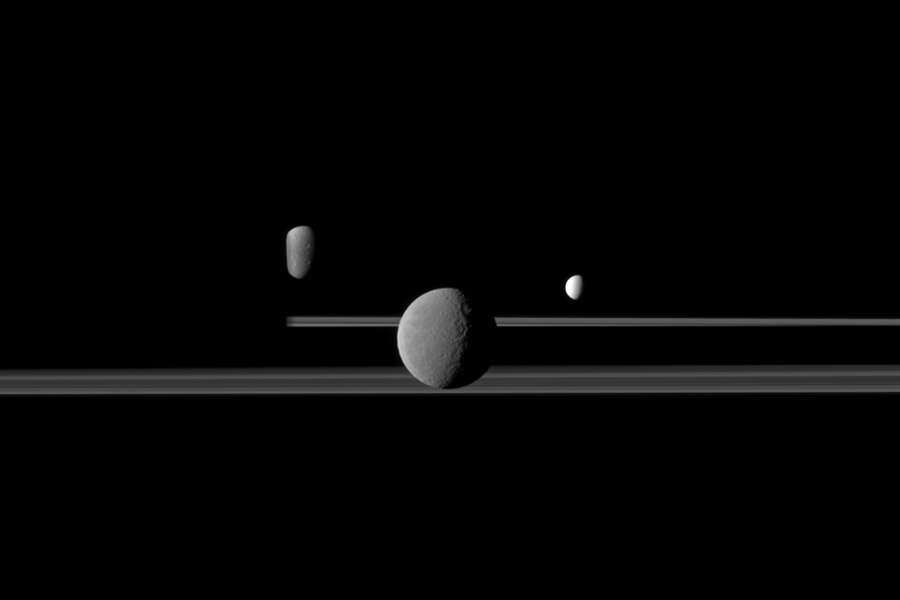
APOD

Orbiting in the plane of Saturn's rings, Saturnian moons have a perpetual ringside view of the gas giant planet. Of course, while passing near the ring plane the Cassini spacecraft also shares their stunning perspective. The thin rings themselves slice across the middle of this Cassini snapshot from April 2011. The scene looks toward the dark night side of Saturn, in the frame at the left, and the still sunlit side of the rings from just above the ringplane. Centered, over 1,500 kilometers across, Rhea is Saturn's second largest moon and is closest to the spacecraft, around 2.2 million kilometers away. To Rhea's right, shiny, 500 kilometer diameter Enceladus is about 3 million kilometers distant. Dione, 1,100 kilometers wide, is 3.1 million kilometers from Cassini's camera on the left, partly blocked by Saturn's night side.
APOD
edit on 29-3-2013 by elevenaugust because: (no reason given)
Would that be something .... if you actually could be there on some station and see this from your window.
double post...
edit on 29-3-2013 by 0bserver1 because: (no reason given)
reply to post by elevenaugust
Very interesting perspective. This is the kind of thing I wish we could see more off. I enjoy the foreign landscapes in science fiction and they are even more amazing when real. What is that straight line up the left portion of the shot though? Is that 2 photos combined? Either that or one of the moons appears flat on one side....Still pretty cool.
Very interesting perspective. This is the kind of thing I wish we could see more off. I enjoy the foreign landscapes in science fiction and they are even more amazing when real. What is that straight line up the left portion of the shot though? Is that 2 photos combined? Either that or one of the moons appears flat on one side....Still pretty cool.
reply to post by newcovenant
It's the dark side of Saturn blocking part of the moon on the left. Cool shot.
It's the dark side of Saturn blocking part of the moon on the left. Cool shot.
Stunning image! I'd love to see this in colour, or better yet with my own eyes.
By the way, this image is part of a sequence, which can be made into an animation:
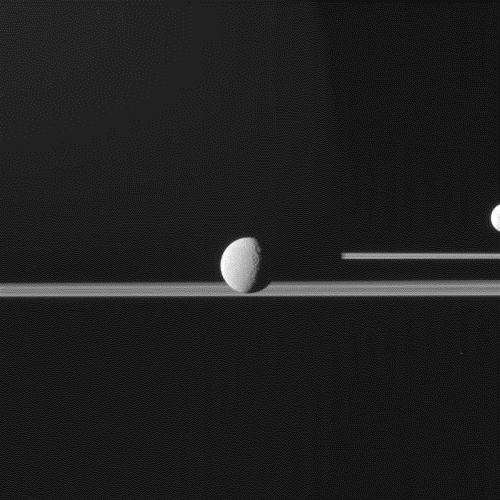
You can find the raw images here: saturn.jpl.nasa.gov...
Here's another cool Cassini image I found, Rhea passing in front of Titan:
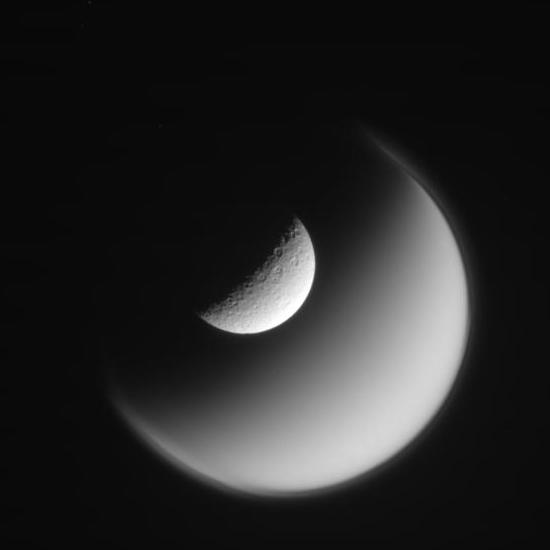
Animation:
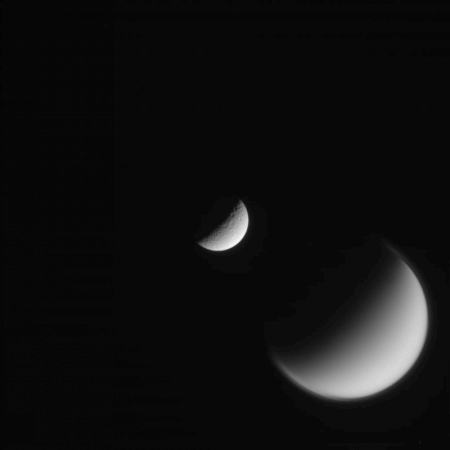
By the way, this image is part of a sequence, which can be made into an animation:

You can find the raw images here: saturn.jpl.nasa.gov...
Here's another cool Cassini image I found, Rhea passing in front of Titan:

Animation:

edit on 30-3-2013 by wildespace because: (no reason given)
reply to post by wildespace
And what colours do you think you would see? The images, from what I can determine, are either taken with a 750 nm filter, or with the clear filter, which means all wavelengths, so it could be from UV to IR. I very much doubt your eyes would see anything at all, but we won't know unless they send a regular camera out there, which they never will.
Stunning image! I'd love to see this in colour, or better yet with my own eyes.
And what colours do you think you would see? The images, from what I can determine, are either taken with a 750 nm filter, or with the clear filter, which means all wavelengths, so it could be from UV to IR. I very much doubt your eyes would see anything at all, but we won't know unless they send a regular camera out there, which they never will.
Originally posted by GaryN
reply to post by wildespace
Stunning image! I'd love to see this in colour, or better yet with my own eyes.
And what colours do you think you would see? The images, from what I can determine, are either taken with a 750 nm filter, or with the clear filter, which means all wavelengths, so it could be from UV to IR. I very much doubt your eyes would see anything at all, but we won't know unless they send a regular camera out there, which they never will.
Gary, I was just thinking about you and wondering when you pop up again in this forum: and here you are! Speak of the devil.
The images in my first animation were taken through RED (649nm), GRN (569nm), and BL1 (455nm) filters. Many of Cassini's images are taken through the clear filter, meaning the whole of visible spectrum reaches the sensor.
You can find more about filters used on Cassini here.
edit on
30-3-2013 by wildespace because: (no reason given)
reply to post by wildespace
So then there is no colour out there, looks pretty bland to me.
Enceladus is interesting, it has a reported albedo of up to 1.4, meaning it reflects more light than it receives, go figure.
Well, someone has to try and keep all this NASA/ESA/whoever garbage science in check, but I think it 's a losing battle . :-(
The images in my first animation were taken through RED (649nm), GRN (569nm), and BL1 (455nm) filters.
So then there is no colour out there, looks pretty bland to me.
Enceladus is interesting, it has a reported albedo of up to 1.4, meaning it reflects more light than it receives, go figure.
and here you are! Speak of the devil.
Well, someone has to try and keep all this NASA/ESA/whoever garbage science in check, but I think it 's a losing battle . :-(
Originally posted by GaryN
So then there is no colour out there, looks pretty bland to me.
Enceladus is interesting, it has a reported albedo of up to 1.4, meaning it reflects more light than it receives, go figure.
Enceladus' 1.4 albedo is the geometric albedo, which can be greater than 1. The one between 0 and 1 is the Bond albedo, and it's 0.99 for Enceladus.
The animation is b&w because I didn't combine the individual images into colour ones; otherwise the animation would consist of just a few frames, and the fast-moving moons would not align. The r/g/b images from Cassini do produce some colours when combined, although achieving the "true-colour" is tricky due to how the individual b&w images are stretched in brightness. Here's an example of mine:
Saturn. Filters used: CB2 (Continuum band 2, which falls in the red part of visible spectrum), GRN, BL1

Here's also a pic of Rhea I made, it's almost pure white because it's covered in ice, but it does show regional variations in colour when enhanced. Filters used: RED, GRN, BL1
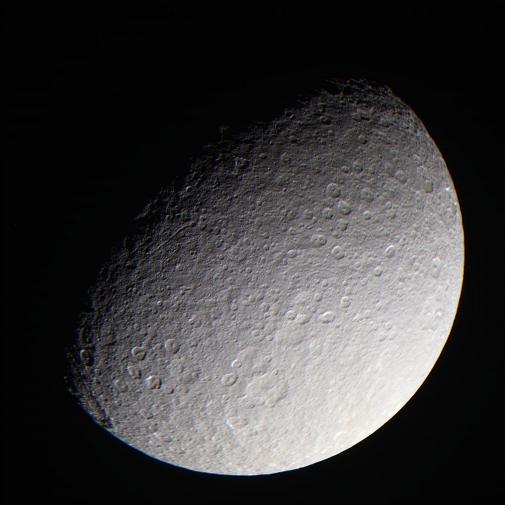
edit on 31-3-2013 by wildespace because: (no reason given)
reply to post by wildespace
Miles Mathis has a pdf on Enceladus. I'm not saying I agree with his charge field explanation, but I think he is correct in that the planets and moons are much brighter than they should be by way of reflection of sunlight. My method involves spatial solitons and vacuum UV, but I don't yet have the math figured out.
milesmathis.com...
So do you still think a regular camera with the Bayer filter would show a colour imgage of Saturn? I sure wish they would just for once send a 'real' camera along with their fancy instruments just so we could see what our eyes would see. And provide the exposure settings too.
The one between 0 and 1 is the Bond albedo, and it's 0.99 for Enceladus.
Miles Mathis has a pdf on Enceladus. I'm not saying I agree with his charge field explanation, but I think he is correct in that the planets and moons are much brighter than they should be by way of reflection of sunlight. My method involves spatial solitons and vacuum UV, but I don't yet have the math figured out.
(M.M.)
It took me a couple of days to realize that Enceladus' bond albedo number of 99+% is actually misdirection itself. After running my own numbers, I could see that Enceladus' “reflectivity” is well above 100%. And the mainstream even admits this, although it misdirects you away from that admission. Bond albedo includes viewing angle, so it can be brought down considerably by that angle. If we want just the brightness at opposition, we use geometric albedo, not bond albedo. Turns out Enceladus has a geometric albedo way over unity, with a value of 1.4. That means it is actually reflecting more light than is falling on it, by the current rules of scattering.
milesmathis.com...
The r/g/b images from Cassini do produce some colours when combined, although achieving the "true-colour" is tricky due to how the individual b&w images are stretched in brightness.
So do you still think a regular camera with the Bayer filter would show a colour imgage of Saturn? I sure wish they would just for once send a 'real' camera along with their fancy instruments just so we could see what our eyes would see. And provide the exposure settings too.
Originally posted by GaryN
reply to post by wildespace
The one between 0 and 1 is the Bond albedo, and it's 0.99 for Enceladus.
Miles Mathis has a pdf on Enceladus. I'm not saying I agree with his charge field explanation, but I think he is correct in that the planets and moons are much brighter than they should be by way of reflection of sunlight. My method involves spatial solitons and vacuum UV, but I don't yet have the math figured out.
(M.M.)
It took me a couple of days to realize that Enceladus' bond albedo number of 99+% is actually misdirection itself. After running my own numbers, I could see that Enceladus' “reflectivity” is well above 100%. And the mainstream even admits this, although it misdirects you away from that admission. Bond albedo includes viewing angle, so it can be brought down considerably by that angle. If we want just the brightness at opposition, we use geometric albedo, not bond albedo. Turns out Enceladus has a geometric albedo way over unity, with a value of 1.4. That means it is actually reflecting more light than is falling on it, by the current rules of scattering.
milesmathis.com...
The geometric albedo of an astronomical body is the ratio of its actual brightness at zero phase angle (i.e., as seen from the light source) to that of an idealized flat, fully reflecting, diffusively scattering (Lambertian) disk with the same cross-section.
The surface materials (regoliths) of airless bodies (in fact, the majority of bodies in the Solar System) are strongly non-Lambertian and exhibit the opposition effect, which is a strong tendency to reflect light straight back to its source, rather than scattering light diffusely. This is why the geometric albedo can be larger than 1. For very bright, solid, airless objects such as Saturn's moons Enceladus and Tethys, whose total reflectance (Bond albedo) is close to one, a strong opposition effect combines with the high Bond albedo to give them a geometric albedo above unity
If Miles Mathis (whoever the hell that guy is) can't understand that, I can't take his theories seriously. I have never heard of him before, and perhaps for a good reason. scientopia.org...
Originally posted by GaryN
I sure wish they would just for once send a 'real' camera along with their fancy instruments just so we could see what our eyes would see. And provide the exposure settings too.
A 'real' camera doesn't see what our eyes would see - not on Earth, not anywhere.
If you can't understand or acknowledge that, then you really are fighting a lost cause
reply to post by Saint Exupery
Huh? My photos seem to look like what my eyes see, what am I not understanding?
A 'real' camera doesn't see what our eyes would see - not on Earth, not anywhere.
Huh? My photos seem to look like what my eyes see, what am I not understanding?
Originally posted by Overtime
reply to post by newcovenant
It's the dark side of Saturn blocking part of the moon on the left. Cool shot.
Yeah I finally saw that when I saw the photo from another source. From the description I thought we were looking at a horizon but we aren't. Thanks.
Very cool.
I love Saturn and it's moons. One of the most interesting places in our solar system!
I love Saturn and it's moons. One of the most interesting places in our solar system!
Friday April 5, Cassini will be making a flyby of Titan, Saturn's biggest moon. It will use its spectrometers to study Titan's atmosphere, but will
take some cool pics too. saturn.jpl.nasa.gov...
Ride along with Cassini to Titan: go.nasa.gov...
Here's a couple of true-colour r/g/b composites of Titan, from Cassini's raw images taken July 24 2012
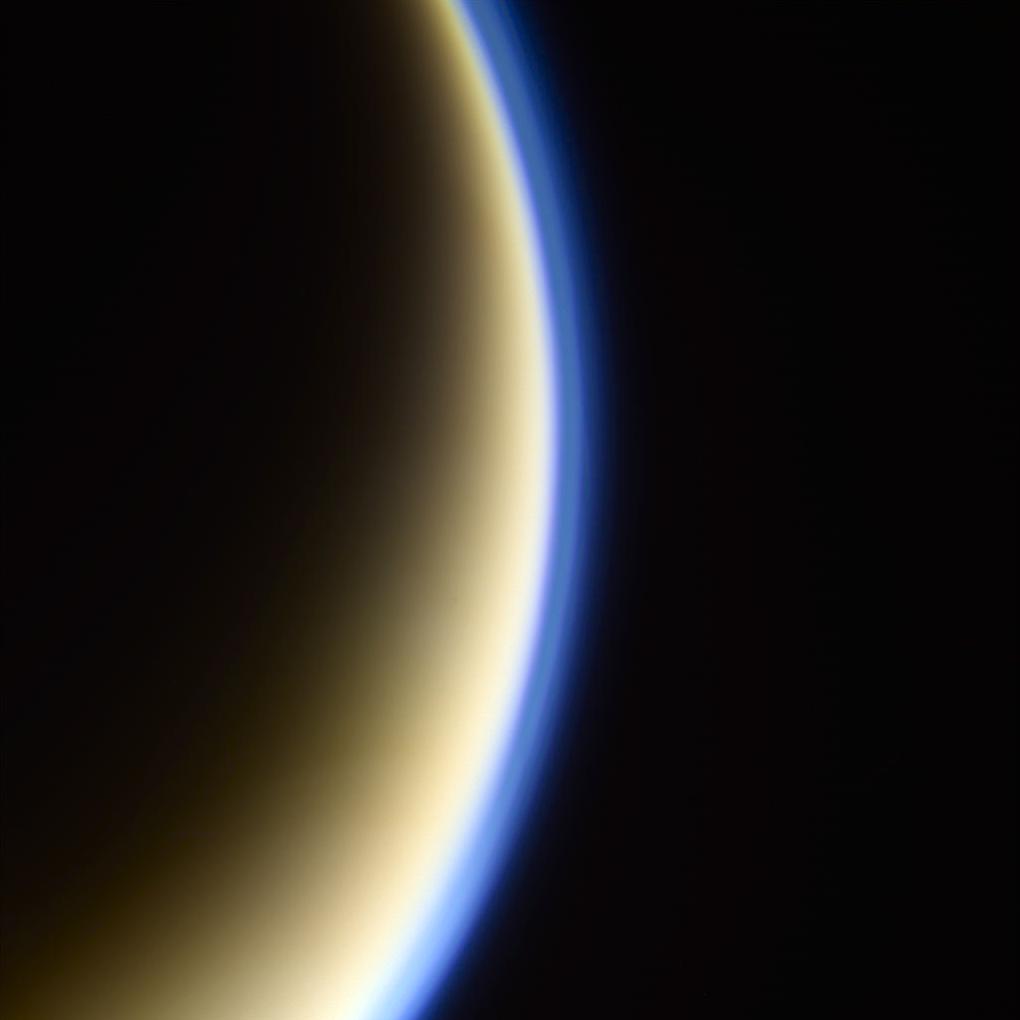

Ride along with Cassini to Titan: go.nasa.gov...
Here's a couple of true-colour r/g/b composites of Titan, from Cassini's raw images taken July 24 2012


reply to post by wildespace
Just wondering if you have any idea of the exposure times for these images? My digging turns up about 38 seconds, but if so, then surely some stars should be visible?
This is the link to the data sets main index:
pds-imaging.jpl.nasa.gov...
Just wondering if you have any idea of the exposure times for these images? My digging turns up about 38 seconds, but if so, then surely some stars should be visible?
This is the link to the data sets main index:
pds-imaging.jpl.nasa.gov...
Originally posted by GaryN
reply to post by wildespace
Just wondering if you have any idea of the exposure times for these images? My digging turns up about 38 seconds, but if so, then surely some stars should be visible?
This is the link to the data sets main index:
pds-imaging.jpl.nasa.gov...
What kind of digging have you done, I'm curious. The images are added to the data sets 1 year after they're taken, so those ones aren't there yet.
I looked at exposure times for similar images of Titan, and they are below 1 sec, some are as short as 0.05 sec.
edit on 3-4-2013 by wildespace
because: (no reason given)
new topics
-
Pentagon acknowledges secret UFO project, the Kona Blue program | Vargas Reports
Aliens and UFOs: 23 minutes ago -
Boston Dynamics say Farewell to Atlas
Science & Technology: 31 minutes ago -
I hate dreaming
Rant: 1 hours ago -
Is the origin for the Eye of Horus the pineal gland?
Philosophy and Metaphysics: 2 hours ago -
Man sets himself on fire outside Donald Trump trial
Mainstream News: 3 hours ago -
Biden says little kids flip him the bird all the time.
2024 Elections: 3 hours ago -
The Democrats Take Control the House - Look what happened while you were sleeping
US Political Madness: 3 hours ago -
Sheetz facing racial discrimination lawsuit for considering criminal history in hiring
Social Issues and Civil Unrest: 3 hours ago -
In an Historic First, In N Out Burger Permanently Closes a Location
Mainstream News: 5 hours ago -
MH370 Again....
Disaster Conspiracies: 6 hours ago
top topics
-
In an Historic First, In N Out Burger Permanently Closes a Location
Mainstream News: 5 hours ago, 14 flags -
The Democrats Take Control the House - Look what happened while you were sleeping
US Political Madness: 3 hours ago, 10 flags -
Thousands Of Young Ukrainian Men Trying To Flee The Country To Avoid Conscription And The War
Other Current Events: 16 hours ago, 8 flags -
A man of the people
Medical Issues & Conspiracies: 11 hours ago, 8 flags -
Man sets himself on fire outside Donald Trump trial
Mainstream News: 3 hours ago, 7 flags -
Biden says little kids flip him the bird all the time.
2024 Elections: 3 hours ago, 6 flags -
4 plans of US elites to defeat Russia
New World Order: 13 hours ago, 4 flags -
Is the origin for the Eye of Horus the pineal gland?
Philosophy and Metaphysics: 2 hours ago, 4 flags -
Sheetz facing racial discrimination lawsuit for considering criminal history in hiring
Social Issues and Civil Unrest: 3 hours ago, 3 flags -
Are you ready for the return of Jesus Christ? Have you been cleansed by His blood?
Religion, Faith, And Theology: 8 hours ago, 3 flags
active topics
-
Fossils in Greece Suggest Human Ancestors Evolved in Europe, Not Africa
Origins and Creationism • 75 • : Xtrozero -
Thousands Of Young Ukrainian Men Trying To Flee The Country To Avoid Conscription And The War
Other Current Events • 33 • : Consvoli -
I hate dreaming
Rant • 4 • : Macenroe1982 -
12 jurors selected in Trump criminal trial
US Political Madness • 103 • : SideEyeEverything1 -
The Democrats Take Control the House - Look what happened while you were sleeping
US Political Madness • 34 • : DBCowboy -
Do we live in a simulation similar to The Matrix 1999?
ATS Skunk Works • 28 • : JoelSnape -
Old School Punk
Music • 537 • : underpass61 -
Pentagon acknowledges secret UFO project, the Kona Blue program | Vargas Reports
Aliens and UFOs • 1 • : imitator -
Man sets himself on fire outside Donald Trump trial
Mainstream News • 28 • : KKLOCO -
Biden says little kids flip him the bird all the time.
2024 Elections • 15 • : SideEyeEverything1
